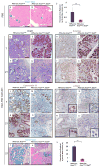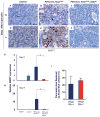Stat3 and MMP7 contribute to pancreatic ductal adenocarcinoma initiation and progression
- PMID: 21481787
- PMCID: PMC3075548
- DOI: 10.1016/j.ccr.2011.03.002
Stat3 and MMP7 contribute to pancreatic ductal adenocarcinoma initiation and progression
Abstract
Chronic pancreatitis is a well-known risk factor for pancreatic ductal adenocarcinoma (PDA) development in humans, and inflammation promotes PDA initiation and progression in mouse models of the disease. However, the mechanistic link between inflammatory damage and PDA initiation is unclear. Using a Kras-driven mouse model of PDA, we establish that the inflammatory mediator Stat3 is a critical component of spontaneous and pancreatitis-accelerated PDA precursor formation and supports cell proliferation, metaplasia-associated inflammation, and MMP7 expression during neoplastic development. Furthermore, we show that Stat3 signaling enforces MMP7 expression in PDA cells and that MMP7 deletion limits tumor size and metastasis in mice. Finally, we demonstrate that serum MMP7 level in human patients with PDA correlated with metastatic disease and survival.
Copyright © 2011 Elsevier Inc. All rights reserved.
Conflict of interest statement
Figures







Comment in
-
The unholy trinity: inflammation, cytokines, and STAT3 shape the cancer microenvironment.Cancer Cell. 2011 Apr 12;19(4):429-31. doi: 10.1016/j.ccr.2011.03.018. Cancer Cell. 2011. PMID: 21481782 Free PMC article.
References
-
- Almoguera C, Shibata D, Forrester K, Martin J, Arnheim N, Perucho M. Most human carcinomas of the exocrine pancreas contain mutant c-K-ras genes. Cell. 1988;53:549–554. - PubMed
-
- Archer H, Jura N, Keller J, Jacobson M, Bar-Sagi D. A mouse model of hereditary pancreatitis generated by transgenic expression of R122H trypsinogen. Gastroenterology. 2006;131:1844–1855. - PubMed
Publication types
MeSH terms
Substances
Grants and funding
LinkOut - more resources
Full Text Sources
Other Literature Sources
Medical
Molecular Biology Databases
Miscellaneous

